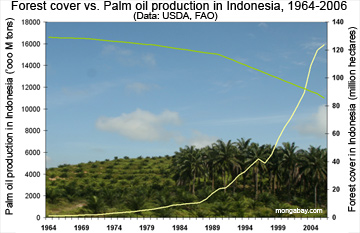Biofuel production on abandoned lands could meet 20% of global oil demand
Biofuel production on abandoned lands could meet 20% of global oil demand
mongabay.com
June 23, 2008
|
|
Using abandoned agricultural lands for biofuel production will meet only a small fraction of global energy needs without compromising food supplies or diminishing biologically-rich habitats, reports a new study published in the journal Environmental Science and Technology.
Using historical land-use data, satellite imaging, and ecosystem models, a team of researchers estimate that 4.7 million square kilometers (1.8 million square miles) of abandoned agricultural lands could be available for producing up to 2.1 billion tons of biomass from energy crops. The biomass would yield an energy content of about 41 exajoules or roughly 7 billion barrels of oil — about 8 percent of current worldwide energy demand or 20 percent of annual oil consumption.
 Forest cover versus palm oil production in Indonesia. |
The researchers say that the United States, Brazil, and Australia have the most extensive areas of abandoned crop and pasture lands, but that Africa could see the biggest gains — up to 37 times current energy consumption — from adopting bioenergy production. Nevertheless the research suggests that biofuels are not the panacea that some policymakers had hoped for meeting future global energy demand.
“Eastern North America has the largest area of abandoned croplands, and the Midwest has the biggest expanse of abandoned pastureland. Even so, if 100% of these lands were used for bioenergy, they would still only yield enough for about 6% of our national energy needs,” said Elliot Campbell, lead author of the study and a research at the Carnegie Institution’s Department of Global Ecology at Stanford University.
“The popular reaction to the recent biofuels papers in Science has been to say that we could still go big with biofuels but along a sustainable path,” he told mongabay.com. “The results in this paper warn that this sustainable path leads to a small amount of energy.”
“Our study shows that there is clearly a potential for developing sustainable bioenergy, and we’ve been able to identify areas where biomass can be grown for energy, without endangering food security or making climate change worse,” added Christopher Field, director of the Department of Global Ecology and a co-author. “But we can’t count on bioenergy to be a dominant contributor to the global energy system over the next few decades. Expanding beyond its sustainable limits would threaten food security and have serious environmental impacts.”
Stanford Global Climate and Energy Project
Related articles
Cellulosic energy may trigger dramatic collapse in the Amazon March 11, 2008
Next generation biofuels may trigger the ecological collapse of the Amazon frontier and could have profoundly unexpected economic consequences for the region, warns a paper published in Philosophical Transactions of the Royal Society B.
Biofuels are worsening global warming February 7, 2008
Converting native ecosystems for production of biofuel feed stocks is worsening the greenhouse gas emissions they are intended to mitigate, reports a pair of studies published in the journal Science. The studies follow a series of reports that have linked ethanol and biodiesel production to increased carbon dioxide emissions, destruction of biodiverse forest and savanna habitats, and air and water pollution.
Biodiesel demand could destroy world’s forests October 4, 2007
Growing demand for biodiesel could drive large-scale forest conversion for energy crops, warns a study published in Conservation Biology. With petroleum supplies expected to peak in the next 5-30 years and growing concern over climate change, biodiesel production may expand by 100-fold by 2050, estimates Lian Pin Koh, a researcher from Princeton University. Koh says that much of this expansion could come at the expense of forests, but the degree of which depends on the feedstocks used. Energy crops like palm oil are significantly more productive than more widely used rapeseed — which currently accounts for 84 percent of biodiesel production — but are more likely to be established in carbon-rich and biodiverse ecosystems like the tropical forests of southeast Asia. As such, the environmental trade-off between feedstocks is complex.
Conservation more effective than biofuels for fighting global warming August 15, 2007
Conserving forests and grasslands may be a more effective land-use strategy for fighting climate change than growing biofuel crops argues a new paper published in the journal Science.